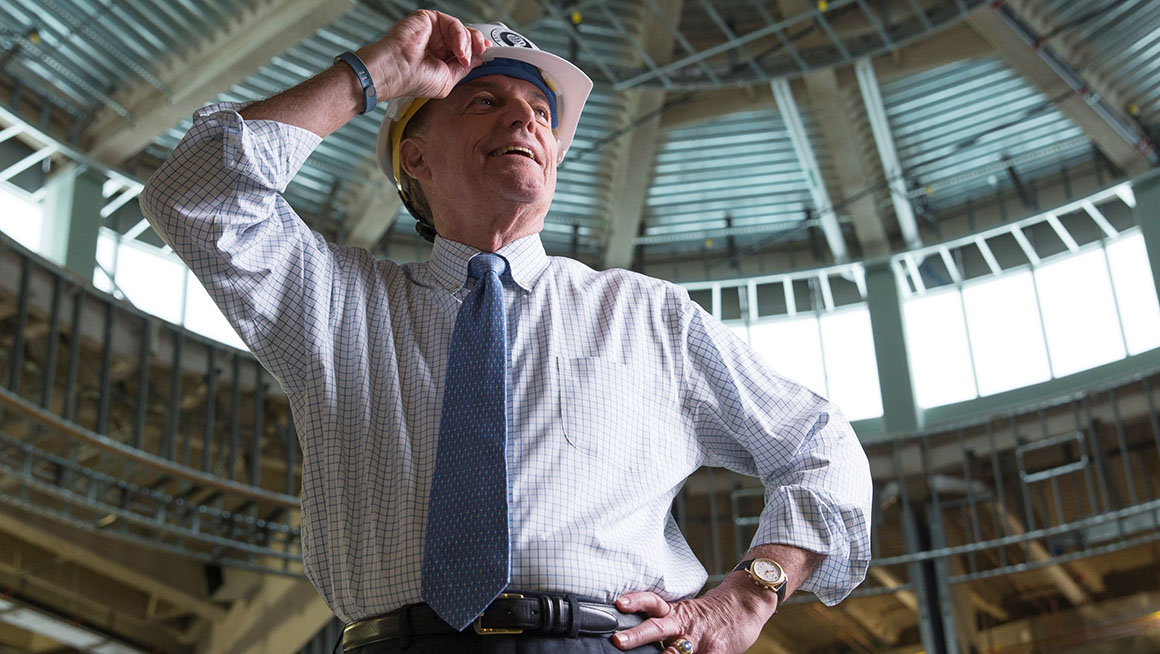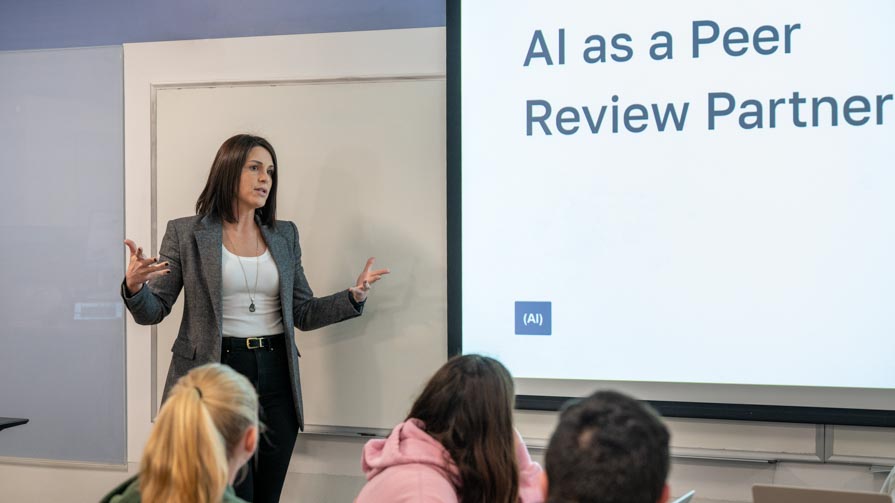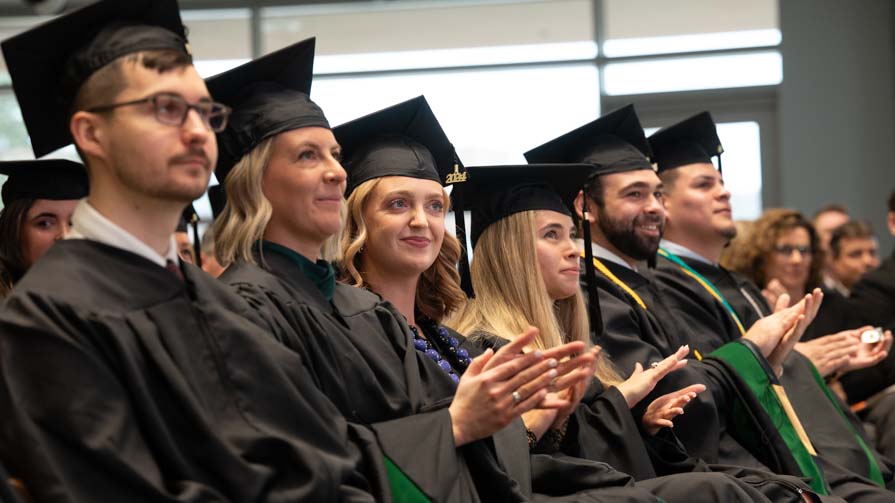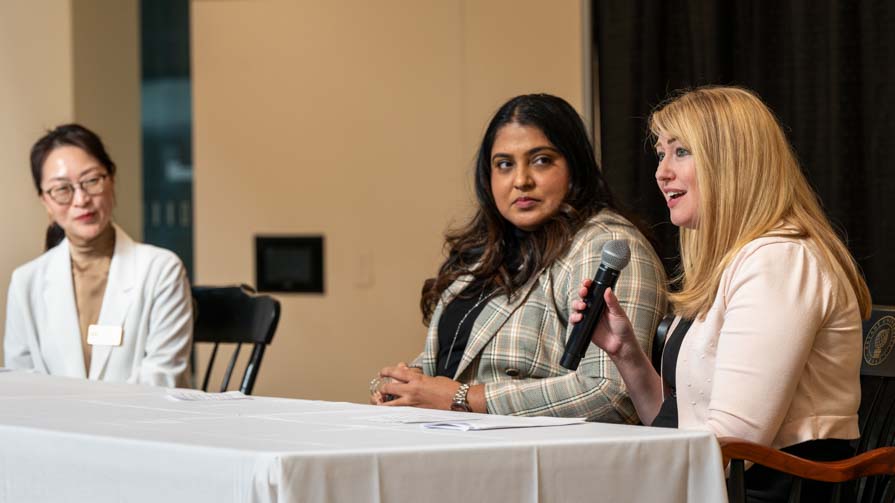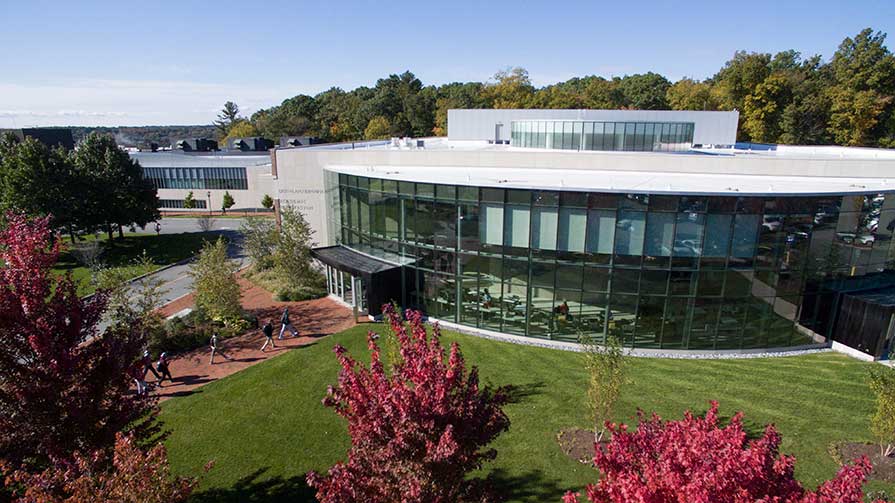Innovation at Bryant has taken many forms over its 154-year history. The current era of innovation was sparked by the recognition that institutions of higher education must evolve more rapidly to develop education models and pedagogies that will ensure that students are prepared for future success in global environment.
Most recently, President Ronald K. Machtley led a team of faculty, administrators, architects, engineers, and builders to create a space that would inspire faculty to think differently about teaching and enable students to take a more active approach to their learning.
Exploration, discovery, and benchmarking
Driven to advance its innovative and transformative programs, Bryant conducted significant exploration and benchmarking visits to some of the country's top institutions to gain insights into the latest innovations in designing educational, working spaces. An intensive five-year period of research, analysis, and development resulted in the creation of Bryant's new Academic Innovation Center (AIC), a vibrant learning laboratory that has ignited Bryant's next era of growth and innovation.
"We have created a world-class learning environment that aligns with Bryant's bold future," said President Machtley. "Our goal is not just to teach innovatively, but to develop within each student the innovative traits, skills and qualities to become innovative leaders for the future."
From groundbreaking to grand opening, the AIC was built in just 16 months to open on time and under budget in September 2016, at a cost of $31.5 million. The facility was part of $75 million in new construction at Bryant, adding 200,000 square feet to the campus facilities blueprint.
A new way of teaching and learning requires a new kind of space
The process of research, exploration, and analysis led to the realization that a more immersive and active way of teaching and learning would require an entirely new kind of environment. The multidisciplinary team set out to create space that would enable more innovative teaching and also advance Bryant's Strategic Vision 2020 to cultivate a culture of innovation throughout the organization.
To accomplish this, the team adopted the IDEO design thinking method to envision how faculty, in a new world of technology, could more fully integrate experiential learning pedagogy in the classroom. This creative problem solving approach follows six steps: observation, ideation, rapid prototyping, user feedback, iteration, and implementation.
Observation
- The development team began to visualize the type of space that would achieve future objectives. Field research included site visits schools like Stanford and Harvard to learn more about state-of-the-art academic spaces to inform Bryant's development process.
Ideation
- At this phase the team collaborated to imagine how faculty could go beyond more traditional teaching methods like PowerPoint presentations, lectures, and tests to a fully integrated pedagogy of active, immersive, experimental learning in the classroom.
Rapid Prototyping
- The first prototype classroom, the Ideation Lab, was designed by adventurous faculty who had participated in the IDEA (Innovation Design Experience for All) program, a three-day design thinking boot camp launched in 2013. They were known for their cutting-edge teaching beyond traditional boundaries. They experimented, evaluated results, and made significant improvements.
- The next prototype iteration, Bello 102 in the George E. Bello Center for Information and Technology, was more sophisticated in its use of wireless technology and audiovisual capabilities, with movable tables and chairs for easy reconfiguration of the space for team tasks.
User Feedback and Iteration
- Throughout the pilot projects, faculty weighed in with feedback, recommendations, and ideas for refinement and improvement. They imagined a whole new building that would reflect the lessons they had learned. The vision for the new space included: an active, fluid learning environment for both the College of Business and the College of Arts and Sciences—a flexible, open, and transparent space with light and movable furniture and state-of-the-art technology tools. The team envisioned group-integrated experiential learning in flipped classrooms and many other possibilities.
Implementation, Integrative Thinking, and Collaboration
- With the research and planning complete, it was time to move into the implementation phase. The team met regularly with the architect, project team, and other stakeholders on campus to guide their vision for this trailblazing new building. The dedication and collaboration of this team proved vital to creating a building that fostered innovative, active learning for all academic programs at Bryant.
Future focused
Kip Ellis of EYP Architecture & Engineering was the lead designer for the AIC, and his passion and talent were critical the success of the project. "The very nature of this endeavor was about the future," said Ellis. "And what I found particularly exciting was the desire to innovate and do something entirely new, to be at the forefront of creating an environment that will encourage innovation, that will encourage new ways of learning."
A new dimension
The AIC promotes the innovative and entrepreneurial spirit that characterizes the Bryant University experience for both students and faculty. The 48,000 square foot architectural masterpiece has added a new dimension to academic life and re-energized the entire community.
"The AIC raises everyone's game," said President Machtley. The meticulously designed spaces—the light-drenched Innovation Forum, five tiered classrooms, five flat classrooms, one divisible classroom, 23 breakout rooms, and L'Artisan Café—together create an environment conducive to innovative teaching, active learning, group interactions, and creative collaboration. Everything is supported by state-of-the-art technology.
The next era of growth and innovation
The inaugural year of the AIC has been one of discovery, exploration, and excitement. The success at all levels reflects the teamwork and dedication of everyone involved in the AIC, from the conception and planning phase, through design and construction to support and innovative use of the spaces. Faculty and students have seized on the opportunities offered by the AIC to try new approaches to teaching and learning, and to highlight and celebrate the innovative work of Bryant's academic community. We anticipate that the new academic year will spark new ideas and directions in advancing the Bryant educational experience.
